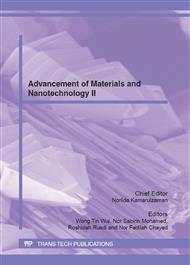[1]
R. Bhuyan, C. N. Saikia, Isolation of colour components from native dye-bearing plants in northeastern India, Journal of Bioresource Technology, Vol. 96, Issue 3 (2005), pp.363-372.
DOI: 10.1016/j.biortech.2004.02.032
Google Scholar
[2]
R. Bhuyan, C.N. Saikia, K.K. Das, Extraction and Identification of Colour Components from the Bark of Mimusops Elengi and Terminalia Arjuna and Evaluation of their Dyeing Characteristics on Wool, Indian Journal of Fibre & Textile Research, Vol. 29, No 4 (2004).
Google Scholar
[3]
R. Gevrenova, Determination of natural colorants in plant extracts by high-performance liquid chromatography, Journal of the Serbian Chemical Society, 75 (7) (2010), p.903–915.
DOI: 10.2298/jsc091027071g
Google Scholar
[4]
R. Siva, Status of natural dyes and dye-yielding plants in India, Current Science, Vol. 92, No. 7 (2007).
Google Scholar
[5]
N.F. Ali, R.S.R. El- Mohamedy, Eco-friendly and protective natural dye from red prickly pear (Opuntia Lasiacantha Pfeiffer) plant, Journal of Saudi Chemical Society, (2010), doi: 10. 1016/j. jscs. 2010. 10. 001.
DOI: 10.1016/j.jscs.2010.10.001
Google Scholar
[6]
R. Mongkholrattanasit, J. I. Kryšt fek, J. Wiener, Dyeing and Fastness Properties of Natural Dyes Extracted from Eucalyptus Leaves Using Padding Techniques, Fibers and Polymers, Vol. 11, No. 3 (2010), pp.346-350.
DOI: 10.1007/s12221-010-0346-8
Google Scholar
[7]
K. N. Vinod et al., Extraction of natural color component from the bark of Belleric myrobalan (Terminalia bellerica): Kinetic and adsorption studies, European Journal Chemistry 1 (3) ( 2010), p.206‐210.
DOI: 10.5155/eurjchem.1.3.206-210.128
Google Scholar
[8]
Bender ML, Komiyama M. Cyclodextrin chemistry. Berlin, Heidelberg, New York: Springer-Verlag (1978), p.2.
Google Scholar
[9]
M. Fermeglia et al., Host–guest inclusion complexes between anticancer drugs and b-cyclodextrin: computational studies, Carbohydrate Polymers, (53) (2003), p.15–44.
DOI: 10.1016/s0144-8617(03)00011-0
Google Scholar
[10]
D. Zhao et al., Water-insoluble b-cyclodextrin polymer crosslinked by citric acid : synthesis and adsorption properties toward phenol and methylene blue, Journal of Inclusion Phenomena and Macrocyclic Chemistry, 63 (2009), p.195–201.
DOI: 10.1007/s10847-008-9507-4
Google Scholar
[11]
Information on http: /pt. treknature. com/gallery/Asia/Malaysia/photo236846. htm, Foozi Saad, Morning Melastoma, Available: [Accessed: 30 Oct 2010].
Google Scholar
[12]
H.T. Lokhande et al., Application Of Natural Dyes On Polyester, American Dyestuff Reporter, Vol 87, No 9 (1998), p.40.
Google Scholar
[13]
H. Goodarzian, E. Ekrami, Extraction of dye from Madder plant (Rubia Tictorium L. ) and Dyeing of Wool, World Applied Sciences Journal 9, (4) (2010), p.434 – 436.
Google Scholar


